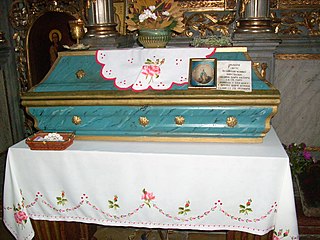Related Research Articles
Anastasius (Latinized) or Anastasios is a masculine given name of Greek origin derived from the Greek word ἀνάστασις (anastasis) meaning "resurrection". Its female form is Anastasia. A diminutive form of Anastasios is Tasos.
Pope Anastasius IV, born Corrado Demetri della Suburra, was head of the Catholic Church and ruler of the Papal States from 8 July 1153 to his death. He is the most recent pope to take the name "Anastasius" upon his election.
Pope Anastasius II was the bishop of Rome from 24 November 496 to his death. He was an important figure in trying to end the Acacian schism, but his efforts resulted in the Laurentian schism, which followed his death. Anastasius was born in Rome, the son of a priest, and is buried in St. Peter's Basilica.
Pope Anastasius I was the bishop of Rome from 27 November 399 to his death on 19 December 401.
Pope Innocent I was the bishop of Rome from 401 to his death on 12 March 417. He may have been the son of his predecessor, Anastasius I. From the beginning of his papacy, he was seen as the general arbitrator of ecclesiastical disputes in both the East and the West. He confirmed the prerogatives of the Archbishop of Thessalonica, and issued a decretal on disciplinary matters referred to him by the Bishop of Rouen. He defended the exiled John Chrysostom and consulted with the bishops of Africa concerning the Pelagian controversy, confirming the decisions of the African synods. The Catholic priest-scholar Johann Peter Kirsch, 1500 years later, described Innocent as a very energetic and highly gifted individual "...who fulfilled admirably the duties of his office".

Anastasius I Dicorus was Eastern Roman emperor from 491 to 518. A career civil servant, he came to the throne at the age of 61 after being chosen by the wife of his predecessor, Zeno. His reign was characterised by reforms and improvements in the government, finances, economy, and bureaucracy of the Empire. He is noted for leaving the empire with a stable government, reinvigorated monetary economy and a sizeable budget surplus, which allowed the Empire to pursue more ambitious policies under his successors, most notably Justinian I. Since many of Anastasius' reforms proved long-lasting, his influence over the Empire endured for many centuries.
The 490s decade ran from January 1, 490, to December 31, 499.
Pope Hormisdas was the bishop of Rome from 20 July 514 to his death. His papacy was dominated by the Acacian schism, started in 484 by Acacius of Constantinople's efforts to placate the Monophysites. His efforts to resolve this schism were successful, and on 28 March 519, the reunion between Constantinople and Rome was ratified in the cathedral of Constantinople before a large crowd.
St. Flavian II of Antioch was the Patriarch of Antioch from 498 until his deposition in 512.
Euphemius of Constantinople was Ecumenical Patriarch of Constantinople (490–496). Theophanes calls him Euthymius. Prior to his appointment, Euphemius was a presbyter of Constantinople, administrator of a hospital for the poor at Neapolis, unsuspected of any Eutychian leanings, and is described as learned and very virtuous.

Severus the Great of Antioch, also known as Severus of Gaza, was the Patriarch of Antioch, and head of the Syriac Orthodox Church, from 512 until his death in 538. He is venerated as a saint in the Oriental Orthodox Church, and his feast day is 8 February.

Solin is a town in Dalmatia, Croatia. It is situated right northeast of Split, on the Adriatic Sea and the river Jadro.
Pope Anastasius of Alexandria, 36th Pope of Alexandria & Patriarch of the See of St. Mark. During his reign, despite being barred from the city of Alexandria, he met with the Patriarch of Antioch as they worked to arrange the unification of their two churches.
Anastasius I of Antioch was the Patriarch of Antioch twice.

Anastasius Sinaita, also called Anastasius of Sinai or Anastasius the Sinaite, was a Greek writer, priest and abbot of Saint Catherine's Monastery on Mount Sinai.

Saint Anastasius of Persia, was originally a Zoroastrian soldier in the Sasanian army. He later became a convert to Christianity and was martyred in 628.
Euphemia, whose original name was Lupicina, was an Empress of the Eastern Roman Empire by marriage to Justin I.

Anastasius was a Christian convert who suffered martyrdom with Anthony, Julian, Celsus and Marcionilla, during the Diocletianic Persecution. He is supposed to have converted after being raised from the dead by Saint Julian of Antioch. His memorial is on 9 January. Anastasius is one of the 140 Colonnade saints which adorn St. Peter's Square. His relics are interred at the Ravanica Monastery in Serbia.

November 17 - Eastern Orthodox liturgical calendar - November 19
Timothy I or Timotheus I was a Christian priest who was appointed Patriarch of Constantinople by the Byzantine emperor Anastasius I in 511.